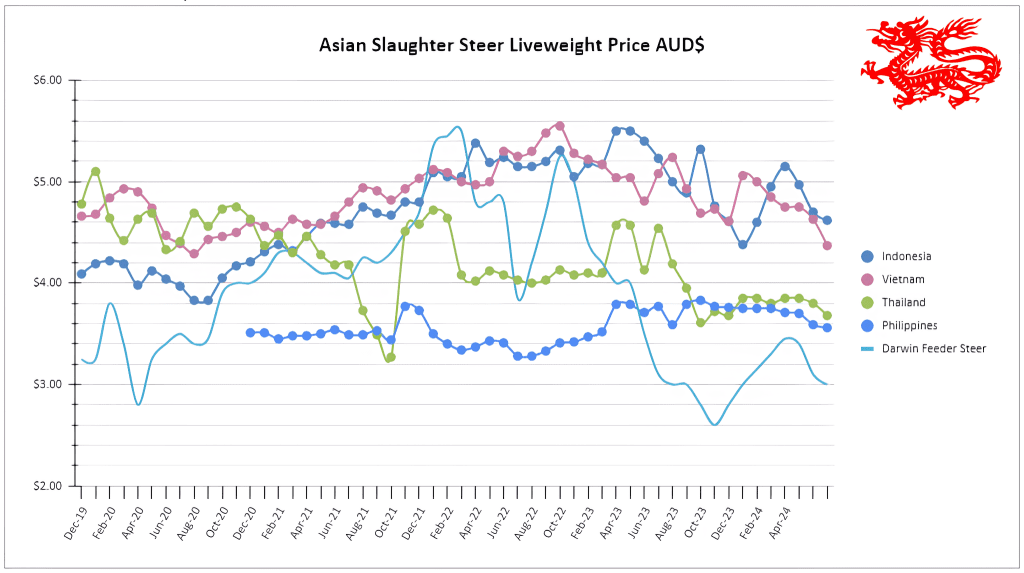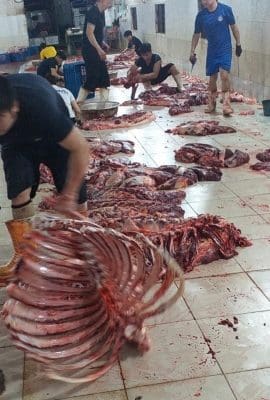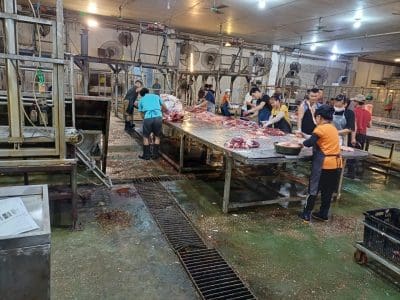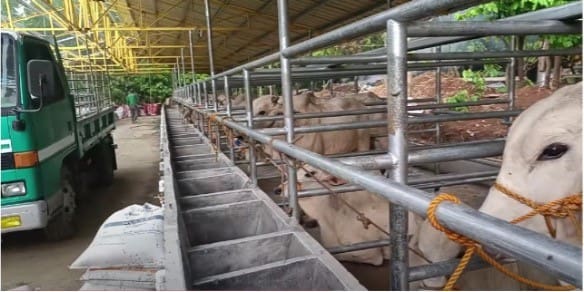
127th Edition: July 2024
Key points:
- Australian exporter feeder prices fueling higher trade volumes
- New player joins Aus export trade to Indo
- Governments in the region look to dairy cattle production as a solution to food security and nutrition needs
- Animal disease remains a significant burden on protein supply
Note: We have stopped reporting our China price indicator this month as we are no longer able to source reliable data.
Regional Trends and Overview
The gap between Australian feeder cattle price and the Indonesian/Vietnam price is maintaining a healthy spread. Cattle export volumes reflect this attractive pricing differential with monthly cattle exports at their highest levels since 2020-21. I expect to see importers continue to take advantage of this beneficial price as much as they can while it lasts, especially given the forecast update in Australian cattle prices going into 2025 and beyond. Unfortunately for our trading partners they only have so much feedlot, abattoir and consumer capacity and these limitations can be frustrating as they know that good price conditions don’t last long in the Australian export context.
Saudi Arabia has approved the import of cattle, goats and sheep from Thailand though it is not clear if there are any commercial interests behind the bid to open up this new live animal trade route. The prospect of cattle exports from Thailand to Saudi is an interesting thought experiment, given that it is a much shorter sailing route than Australia, but the challenge of aggregating enough export ready cattle in Thailand to fill a ship is unlikely to be something that local operators have the capacity to do in the short term. Even for the well established trade of cattle between Thailand and Vietnam it is a constant challenge for importers to source large volumes of cattle at the price and specification they need.
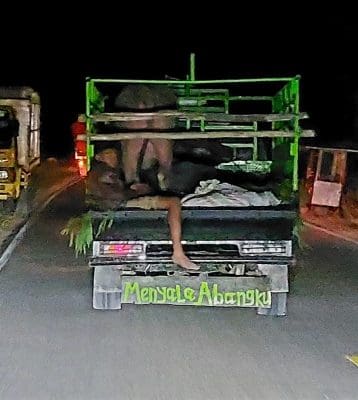
Photo: Cattle transport in Sumba, Indonesia. The cattle are quiet and there is obviously lots of trust by the owners.
I am in Sumba as I write this article. It is an Indonesian island South East of Bali and it is always fascinating to see the different livestock transport used in the region. In Sumba the local trucks in the photo are used for transporting people, livestock, and every type of good you can think of. The multi use vehicles are a more efficient way to mobilise resources as they generally only transport livestock in the evening.
There are risks with flooring, long transport times on poor roads without water, biosecurity, and lack of loading and unloading ramps.
While there are no enforced regulations on the movement of the animals, because everything is done in lower volumes there is more time and attention placed on making sure the livestock are secure and safe, as there is no benefit in injuring animals during the process.
Indonesia: Slaughter Steers AUD $4.62 / kg live weight (IDR 10,940 = 1 AUD)
Trading conditions very competitive
Some Indonesian feedlots are reportedly close to capacity after a busy few months as importers have made up for the supply gap created by delayed import permit issuing at the start of the year and to take advantage of attractive pricing. With some exporters committing to multi-voyage charters of vessels they can find themselves in a situation where they need to sell cattle to keep that vessel utilised and costs efficient. When multiple exporters are doing this it quickly creates a very competitive market and puts downwards pressure on the sell price. My contacts report CIF prices in the $2.60-$2.80 USD ($3.83 – $4.13 AUD) for various lines of cattle delivered to Jakarta or Lampung, some of the lowest prices seen by our Indonesian customers for several years.
Prices
The beef price trends from June to July 2024 have shown notable fluctuations over the past two months. Initially, there was a general increase towards the end of June, followed by a slight decline at the beginning of July. This fluctuation can be attributed to cultural factors, as demand typically rises during the Eid Al-Adha season. If consumers do not obtain beef through Qurban rituals, they often turn to purchasing it, influencing market dynamics.
In July, carcass prices saw a slight drop to between $8.96 and $9.14 AUD (98,000 to 100,000 IDR) per kg. In contrast, during June, average beef prices ranged from $12.34 to $12.43 AUD (135,000 to 136,000 IDR) per kg. Entering July, prices moderated slightly to $12.16 to $12.34 AUD (133,000 to 135,000 IDR) per kg.
The fluctuation in prices may also be linked to the depreciation of the Indonesian Rupiah, which now stands at Rp 16,400 per USD. This currency devaluation has raised concerns among feedlot operators regarding its potential impact on domestic beef stocks and prices. Didiek Purwanto, Chairman of the Indonesian Beef Cattle Business Association (Gapuspindo), noted that the exchange rate’s depreciation exceeded earlier predictions based on the 2024 state budget’s macroeconomic assumptions (Rp 15,000 per USD). Consequently, many importers are now seeking pricing denominated in AUD from Australian exporters to mitigate risks associated with currency fluctuations.
A new player in the market
The talk of the town in the Indonesian import market is that AAM Investment Group (AAM) has entered the fray of the Indonesian cattle market, reportedly under an arrangement with PT Indo Prima Beef to import and market its own cattle into Indonesia, with AAM cattle already in-country and moving through the supply chain. This direct involvement of one of Northern Australia’s biggest profile cattle producers, headed by Garry Edwards (also chair of Cattle Australia) has added a new dynamic to the market. AAM has picked up several staff with export experience both on the Australia side and locally in Indonesia which puts them in good stead for dealing with the complexities of the market. AAM appears to be using the services of established live exporters to transport its cattle to Indonesia. Several of my contacts reported that the injection of a new supplier into the market is unsurprisingly rocking the cart, with many observers eagerly watching to see how the new kid on the block goes in what is a very mature and at times cut-throat market.
Qurban
The economic potential of the Qurban market in Indonesia is substantial, as highlighted by the Institute for Demographic and Poverty Studies (IDEAS), which reported sales amounting to $2.8 billion AUD (IDR 28.2 trillion) in June 2024, involving 2.16 million participants. This market demand focused predominantly on 1.21 million goats and sheep, with cattle and buffalo accounting for 587,000 animals. Despite a recovery in middle-class incomes, there was a noted decline in goat and sheep sacrifices attributed to economic challenges, a sentiment echoed by industry contacts facing challenging trading conditions during the festival period.
The purchase of sacrificial animals represents a significant financial commitment for Indonesian families participating in Qurban. To enhance the process in 2024, government initiatives included certifying halal slaughterers and improving livestock transportation logistics. These efforts aim to streamline operations and ensure compliance with halal standards, crucial for the religious observance.
The Qurban market presents substantial economic opportunities and it reflects broader economic trends and governmental efforts aimed at enhancing efficiency and adherence to religious practices.
Free Lunch Program
Under the leadership of Minister Andi Amran Sulaiman, the Ministry of Agriculture is actively promoting the expansion of meat and dairy production in Indonesia, focusing particularly on livestock such as cattle, goats, and sheep. The minister has articulated key priorities including regulatory simplification, ensuring access to quality seeds and breeds, facilitating land availability, providing financial incentives, improving logistical infrastructure, and offering comprehensive business support. These efforts are geared towards establishing an integrated system that promotes efficient, sustainable, and environmentally-friendly agricultural practices.
In a significant development, the Ministry has initiated collaborations with prominent private sector entities, such as Royal FrieslandCampina NV, a leading Dutch dairy producer. Together, they are launching a pilot program for the free lunch initiative (MBG). Starting in August, PT Frisian Flag Indonesia, a subsidiary of FrieslandCampina, will implement a six-month trial at 10 schools in Cikarang, near Jakarta. This pilot program, albeit modest in scale initially, represents a foundational step towards potentially providing free lunches to over 80 million school children nationwide in the future.
Vietnam: Slaughter Steers AUD $4.63 / kg live weight (VND 17,149 = 1AUD)
Prices
A quieter month for cattle exports to Vietnam, likely the result of shipping space being allocated to Indonesia which saw volumes of more than 20% above the five-year-average for June. Australian cattle prices in-country are remaining fairly consistent, with significant flows of cattle also coming in from Thailand and Myanmar.
Diseases continue to present repeat challenges
Animal diseases have rapidly spread among cattle and poultry in multiple regions of Vietnam, with widespread animal smuggling identified as a primary cause, according to the Ministry of Agriculture and Rural Development. This year, Vietnam has recorded 660 outbreaks of African swine fever, a substantial increase from the 208 outbreaks during the same period last year. As a result, approximately 22,000 pigs have been culled, reflecting a 94 percent year-on-year rise. The increased pork prices due to these outbreaks are pushing consumer price indexes up. Numerous provinces are grappling with the swift transmission of African swine fever, bird flu, and hand, foot, and mouth disease, leading to increased inspections and control measures by local authorities.
Impetus Animal Welfare wraps up its AVEG project
The Impetus AVEG project was undertaken to enhance economic engagement between Australia and Vietnam by focusing on improving animal welfare and developing the cattle abattoir sector. This initiative involved comprehensive site assessments to identify infrastructure and training needs. The resulting Investment Insights Report provides an in-depth analysis of potential investment opportunities, noting significant variations in the scale of operations and highlighting key areas for improvement. For instance, the report reveals that most abattoirs process fewer than two head of Australian cattle daily, emphasising the need for better processing capabilities and modern equipment. The report also identifies a number of abattoirs with high investability potential for targeted development efforts. For those interested in reading the report, please contact me directly at michael@impetusanimalwelfare.org.
Local abattoir systems in Vietnam
Philippines: Slaughter Steers AUD $3.56 / kg liveweight (P. 39.51 = 1AUD)
Prices
The Philippines Peso has continued to weaken which is keeping imported staples like rice and oil expensive. This is also making local cattle relatively cheaper compared to Australian cattle. In wet markets and supermarkets alike, beef knuckle has been between P. 580/kg($14.68 AUD) and P. 630/kg($15.95), respectively. Local cattle prices in Mindanao are still pegged between P. 130-145/kg($3.29-$3.67 AUD) liveweight, and the hot carcass meat price is approximately P. 260/kg($6.58 AUD).
Live pork prices are around P. 185.00 to P. 195.00 per kilo ($4.68-$4.94 AUD), and pork carcass goes for P. 260.00 per kilo ($6.58 AUD). In supermarkets, non-branded broiler chicken is priced at P. 175.00 per kilo ($4.43 AUD), while the Magnolia brand is priced at P. 227.00 per kilo ($5.75 AUD).
Dairy production a national focus
The National Dairy Authority (NDA) in the Philippines has announced plans to import 5,000 cattle to boost local milk production to 80 million litres by 2028. In 2023, the Philippines produced 22.87 million litres of milk, up from 21.93 million litres in 2022, but still imports 99% of its annual milk requirement of 3.3 million metric tonnes. Danilo Fausto, president of the Dairy Confederation of the Philippines, emphasised the need for a $84 million AUD (P2.5 billion) budget to support local production and improve dairy genetics through artificial insemination with the Philippines government currently allocating about $14 million AUD (P420 million) thus far.
Australia: Feeder Steers Darwin $3.00, Townsville $2.60
Feeder steers out of the North have been dipping in to the high $2 AUD range over the last month despite high volumes and plenty of buying by exporters. Second grade feeder export steers and bulls have been quoted as low as $2.20 in Queensland with Brahman feeder heifers down to $2.10. This type of pricing could pique the interest of secondary markets like Malaysia, Philippines and Brunei which have thus far been fairly slow in 2024.
2024 Year to January figures for cattle sea freight across Asia by state
| Country | NT | QLD | VIC | WA | Grand Total |
| Brunei Darussalam | 819 | 819 | |||
| China | 30,402 | 1,904 | 32,306 | ||
| Indonesia | 48,548 | 49,963 | 1,800 | 29,070 | 129,381 |
| Malaysia | 1,200 | 1,200 | |||
| Philippines | 2,282 | 1,610 | 2,786 | 6,678 | |
| Vietnam | 20,219 | 11,818 | 32,037 | ||
| Grand Total | 51,649 | 70,182 | 35,012 | 45,578 | 202,421 |
Source: DAFF website
Year 2024 to January for cattle sea freight comparison across Asian markets
| Country | 2019 | 2020 | 2021 | 2022 | 2023 | 2024 | Grand Total |
| Brunei Darussalam | 5,021 | 8,237 | 13,005 | 5,335 | 3,282 | 819 | 35,699 |
| China | 157,787 | 129,637 | 96,826 | 140,651 | 78,723 | 32,306 | 635,930 |
| Indonesia | 668,941 | 464,077 | 409,036 | 338,200 | 359,305 | 129,381 | 2,368,940 |
| Malaysia | 16,630 | 21,386 | 17,566 | 3,896 | 4,326 | 1,200 | 65,004 |
| Philippines | 17,528 | 20,892 | 20,602 | 7,059 | 18,653 | 6,678 | 91,412 |
| Thailand | 1,669 | 1,736 | 2,060 | 1,772 | 1,674 | 8,911 | |
| Vietnam | 277,280 | 297,709 | 166,227 | 58,200 | 126,930 | 32,037 | 958,383 |
| Grand Total | 1,144,856 | 943,674 | 725,322 | 555,113 | 592,893 | 202,421 | 4,164,279 |
Source: DAFF website

